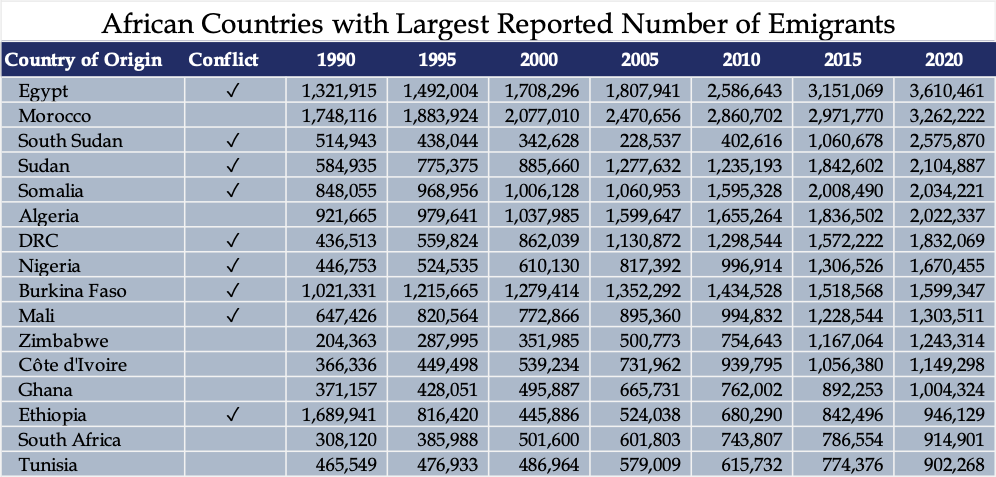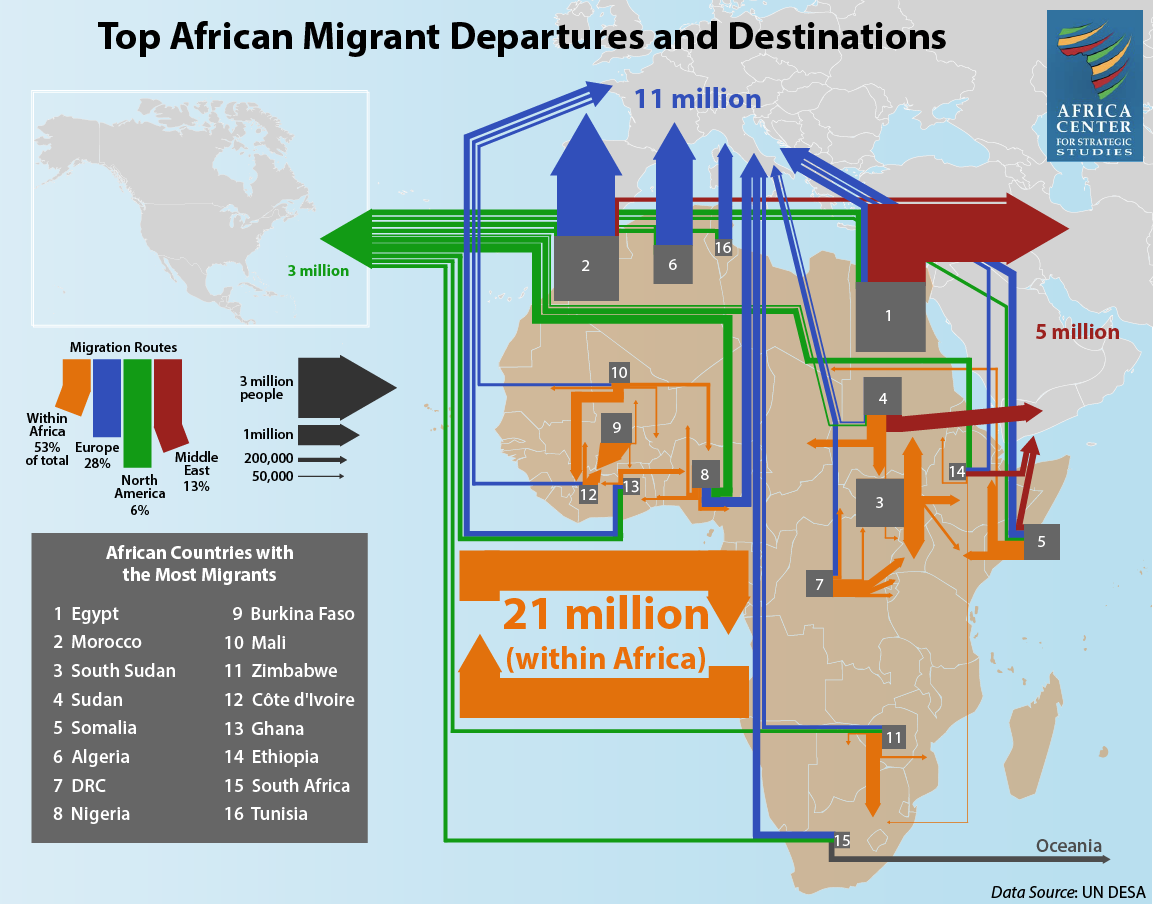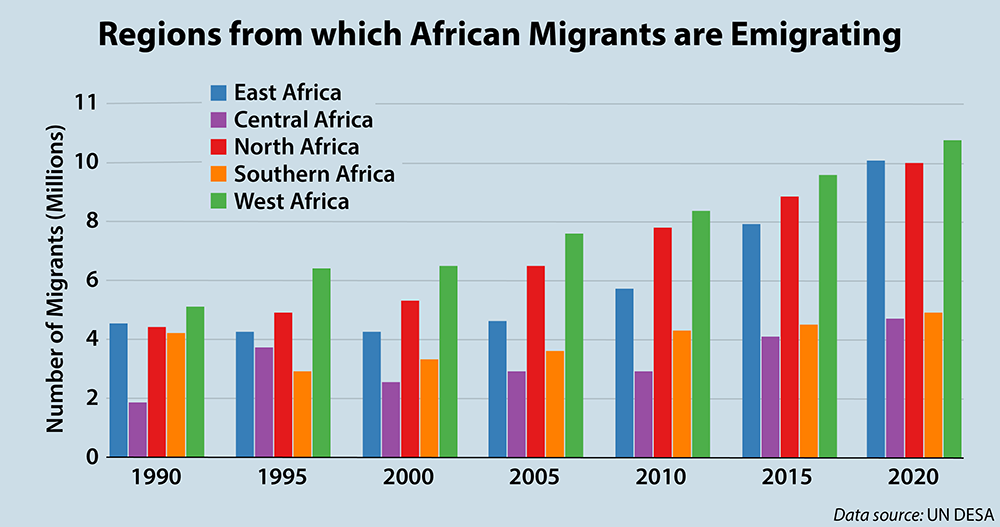African Migration Trends Continue to Escalate
- The number of documented migrants within and from the African region has nearly doubled since 2010, continuing a two-decade trend of expansion.
-
- African migration is being driven by a varied combination of push-pull factors for each country. The primary push factors are conflict, repressive governance, and limited economic opportunities. Nine of the top 15 African countries of origin for migrants are in conflict.
- North Africans make up the majority of African immigrants to Europe. The top three—Morocco, Algeria, and Tunisia—comprise over 5 million of the 11 million African migrants in Europe. This underscores the importance of proximity, established diasporas, and economic opportunity as key “pull” factors influencing migration decision making.
- Surveys of African migrants in or heading toward Europe reveal that the majority were either employed or in school at the time of their departure. Yet, they felt despair over their economic prospects. Tunisians fleeing economic pressures, for example, comprised more than a quarter of the irregular migrants intercepted crossing the Mediterranean to Italy in 2021.
- Migrants tend to have resources at hand—either in the form of jobs or from familial networks of support—especially when family members are already in another country.

Data Source: UN DESA
Most African Migration Remains Intraregional
- Most African migration remains on the continent, continuing a long-established pattern. Around 21 million documented Africans live in another African country, a figure that is likely an undercount given that many African countries do not track migration. Urban areas in Nigeria, South Africa, and Egypt are the main destinations for this inter-African migration, reflecting the relative economic dynamism of these locales.
- Among African migrants who have moved off the continent—some 11 million live in Europe, almost 5 million in the Middle East, and more than 3 million in Northern America.
Climate Disasters Will Continue to Increase Vulnerability Potentially Causing More Migration
- The African continent is facing a faster rate of natural disaster events than the rest of the world. From droughts to floods to cyclones to pandemics, the continent faces many natural drivers of instability.
- The World Bank projects there will be 86 million climate change migrants in Africa by 2050. Some of the 18 million seasonal migrant workers in Africa may find their jobs in agriculture, mining, and fishing disappearing, increasing the prospects for permanent migration in search of new job opportunities. Thirty percent of West and Central Africans and Ethiopians have reported environmental impacts on their economic conditions.
Vulnerability Leading to Trafficking
- COVID-19-related border closures resulted in tens of thousands of migrants stranded across Africa. Many lost their jobs, some their homes. Even after borders re-opened, continued travel and health restrictions have impacted mobility for both regular and irregular migrants. In North Africa, as crossings from Libya to Europe became more difficult, irregular migration toward Europe shifted further west toward Morocco and the Canary Islands. Those attempting to leave from Libya, face continued human rights abuses and involuntary internment.
- Tens of thousands of migrants from Ethiopia in the Gulf States were detained in crowded and unsanitary conditions, and then deported. Many who remained reported instances of wage theft and being coerced into more exploitative contracts with fewer protections due to their inability to leave.
- An estimated 32,000 African migrants remain stranded in Yemen, after attempting to reach the Gulf States. Some of them have become victims to trafficking, such as being forced to work on farms to pay off their debts and being abducted for ransom. As a reflection of their desperation, since May 2020, 18,200 migrants have hired smugglers to take them back from Yemen to the Horn of Africa, according to IOM.
- While migrants are not themselves a security threat, locking them up in detention or denying them assistance and the ability to return home or continue their journeys is empowering unscrupulous actors who see an opportunity to exploit them. Violent extremist groups and criminal networks also continue to benefit financially by controlling migrant smuggling and trafficking routes.
Additional Resources
- Chris Horwood and Bram Frouws (eds.), “Mixed Migration Review 2021,” Mixed Migration Centre, 2021.
- International Organization of Migration, “World Migration Report 2022,” 2021.
- Albert G. Zeufack, Cesar Calderon, Megumi Kubota, Vijdan Korman, Catalina Cantu Canales, Alain N. Kabundi, “Africa’s Pulse, No. 24,” World Bank, October 2021.
- Wendy Williams, “Shifting Borders: Africa’s Displacement Crisis and Its Security Implications,” Africa Center Research Paper No. 8, Africa Center for Strategic Studies, October 2019.
More on: Migration




